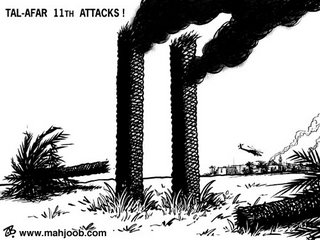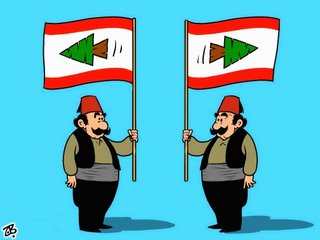The new issue (April-Mai 2006) of the French magazine "Maniere de Voir"has some interestin articles on the Maghreb from the late medieval to the contemporary periods. "Maniere de Voir", which is edited by Ignacio Ramonet just like Le Monde Diplomatuqe, is usually focusing on contemporary issues (mostly theoretical problems); this time it tends to see the contemporary from a historical, longue duree, point of view, which I think is a brilliant idea: an opportunity for some historians to be involved in public debates even though from their own historical perspective.
____________________________________________________________ Manière de voir 86 AVRIL - MAI 2006 LE MAGHREB COLONIAL En vente en kiosque : 7 euros ___________ s o m m a i r e _________________ http://www.monde-diplomatique.fr/mav/86/
Colonialisme Ignacio Ramonet
I. Relations et conquête Dans cette première partie sont évoquées les relations diplomatiques, bien plus riches qu’on l'imagine, entre la France et le Maghreb, pendant les siècles qui précédèrent la conquête de l'Algérie. Et les mesures qui devaient conduire à l'établissement de protectorats en Tunisie et au Maroc. Dès le XVIe siècle, la France protégeait les intérêts européens en Tunisie Aimé Dupuy * Le régime international du Maroc depuis la fin du XIXe siècle Gilles Lapouge * L'« amiral des mers marocaines » chez Louis XIV Aimé Dupuy * Jean-Baptiste Estelle, consul de Louis XIV au Maroc Jacques Caillé * Le Maroc vu et prévu par Lyautey Yves Florenne * Un ambassadeur marocain à Paris sous la monarchie de Juillet Jacques Caillé * Le capitaine Burel, émissaire de Napoléon Ier à Meknès Jacques Caillé * La Tunisie, du protectorat à l'autonomie interne Gilles Lapouge * Un envoyé extraordinaire du bey de Tunis à la cour de Louis XVI Aimé Dupuy * Le bey de Tunis et l'« affaire d'Alger » Aimé Dupuy * Le trésor du dey d'Alger, causes et leçons d'une expédition Aimé Dupuy * 1912-1919 : premier « dérapage » de la politique algérienne Robert Gauthier http://www.monde-diplomatique.fr/mav/86/GAUTHIER/13315 * Des consuls français auprès d'Abd El-Kader Pierre Loevenbruck * Comment débuta l'exil à Paris de Hussein Pacha, dernier dey d'Alger Aimé Dupuy * Colonialisme, une loi contre l'histoire Claude Liauzu * Comment l'armée découvrit les Arabes et leurs « pittoresques » coutumes Jules Bertaut * Le film colonial et l'homme maghrébin Pierre Boulanger II. De l'autonomie aux indépendances Les années 1920 avaient été marquées, au Maghreb, par la « pacification » du Maroc, l'insurrection d'Abd El-Krim et la guerre du Rif. Au cours de la décennie suivante, les opérations militaires diminuent, mais la colonisation s'intensifie. Confisquées aux paysans locaux, de nouvelles terres sont distribuées aux colons européens, lesquels arrivent en masse en raison du chômage - crise de 1929 - qui frappe l'Europe, ou pour se soustraire aux répressions fascistes (c'est le cas de milliers d'Espagnols réfugiés en Algérie pour fuir Franco, ou des Italiens installés en Tunisie pour échapper à Mussolini). La seconde guerre mondiale constitue une coupure dans l'histoire coloniale du Maghreb. La défaite de la France en 1940 frappe soudain les esprits. Victorieux et dominateurs depuis longtemps en Afrique du Nord, les militaires français se retrouvent rapidement vaincus en métropole. Occupante du Maghreb, la France devient à son tour occupée par les Allemands. Qui plus est, pour sa propre libération, elle doit compter sur les goumiers marocains, les spahis algériens et les tirailleurs tunisiens qui, sur le sol européen, participent en masse aux combats et à la victoire des Alliés contre l'Allemagne nazie. Plus rien ne sera comme avant. Dès leur création, en octobre 1945, les Nations unies affirment « le principe de l'égalité de droit des peuples, et le droit des peuples à disposer d'eux-mêmes ». Au nom de ces principes qui fondent le monde contemporain, les sociétés maghrébines reprennent leur marche vers la liberté. * Depuis Montaigne, le courant anticolonialiste a toujours existé en France Aimé Dupuy * La guerre d'Algérie a commencé à Sétif Mohammed Harbi * Les réformes de 1947 et l'intégration algérienne Gilles Lapouge * Une suite d'hésitations et d'erreurs a retardé la décolonisation tunisienne Charles-André Julien * Les « provinces » espagnoles du Maghreb posent un difficile problème de décolonisation Non signé * L'unité de l'Algérie Pierre Bourdieu * L'« Algérie du silence » a trouvé ses écrivains publics Robert Gauthier * M. Ben Bella, « zaïm » de l'Algérie Jean Lacouture * La revendication culturelle des Berbères de Grande Kabylie Yves Lacoste et Camille Lacoste-Dujardin * Réforme agraire et reconversion des colons René Dumont * De Jugurtha à Ferhat Abbas, tous les chemins mènent au Maghreb Kateb Yacine * Le Maghreb aujourd'hui Abdelkébir Khatibi Biographies : — Ibn Battuta, le plus grand voyageur arabe — Ibn Khaldun, le père de la sociologie politique — Abd El-Kader, émir de la résistance algérienne — Abd El-Krim, le stratège de la guerre du Rif — Lyautey, un colonialiste paradoxal — Habib Bourguiba, fondateur de la Tunisie moderne — Mohammed V, père de l'indépendance du Maroc — Hassan II, un redoutable manoeuvrier — Houari Boumediène, bâtisseur de l'Etat algérien Cartographie : — Le Maghreb colonial — Le Maghreb contemporain Jasmine D. Salachas Documentation : Chronologies, bibliographies et sites Internet Olivier Pironet Iconographie : Nous avons voulu présenter un échantillon de ce que fut l'« illustration coloniale » à travers un choix assez varié de cartes postales anciennes, d'affiches politiques, de gravures, de peintures et de photos d'époque qui témoignent tantôt d'une esthétique orientaliste, tantôt du mépris et du racisme ordinaire, ou encore de la recherche du pittoresque ou des fantasmes coloniaux.

















